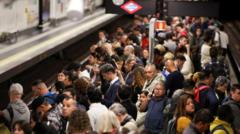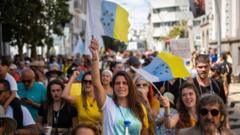Spain's recent national blackout prompted a rapid recovery, but it unveiled significant vulnerabilities within its electricity grid. While the nation worked to restore power, discussions arose regarding the implications of renewable energy dependence and the need for improved infrastructure to prevent future outages.
Spain's Recovery from a National Blackout: A Lesson in Resilience

Spain's Recovery from a National Blackout: A Lesson in Resilience
After experiencing an unprecedented blackout, Spain gradually restored power, highlighting the challenges posed by reliance on renewable energy sources.
As life in Spain and Portugal gradually returns to normal following an enormous blackout, authorities are reflecting not only on the causes of this unprecedented event but also on how to better safeguard against future failures. At 11:15 a.m. on Tuesday, nearly 23 hours following the collapse, Spain's electricity system was declared operational once again. Although public transport is resuming and most homes are regaining electricity, questions linger over the lengthy recovery process and the initial chaos of the outage.
The turmoil of Monday was rooted in simultaneous connection failures in the southwest of Spain, compounded by a disconnection from France's electricity network for nearly an hour. Prime Minister Pedro Sánchez noted the sudden loss of 15 gigawatts of power at 12:33 p.m. that day, representing over 60% of the country's generation capacity. Officials from Red Eléctrica, Spain’s grid operator, pointed to the stability of the system prior to the outage, which ultimately affected all regions except for the Balearic Islands and certain North African territories.
Public discourse has increasingly fixated on the risks tied to Spain's heavy investment in renewable energy. Just minutes before the blackout, solar energy accounted for 60.64% of electricity generation, with supplementary contributions from wind and nuclear sources. Following the blackout, the immediate response was focused on gradually restoring power to the northern and southern generating regions to mitigate the risk of a second failure. This delicate process, referred to as a "black start," involved a phased approach to reconnecting power sources.
Hydro-electric and combined-cycle gas plants played critical roles in reviving the grid, while several nuclear reactors were automatically shut down during the incident. Support from neighboring countries further eased the recovery, with Morocco supplying 900 megawatts through cross-border lines, and France restoring electricity transfer shortly after the outage began. By late Monday, substantial power was regained, notably through both domestic generation and imported electricity.
By 19:20 on Monday, more than 20% of power needs had been satisfied, with electricity provider Endesa having restored service to approximately 3.5 million customers by 19:15, prioritizing hospitals and essential infrastructure. Gradual improvements saw overall demand restoration climb from 35% to over 99% by the next morning.
The blackout’s economic toll is already estimated at €1.6 billion, intensifying political critique regarding the response measures taken. Some leaders criticized the government for perceived ineffectiveness, while the resilience of citizens has been acknowledged, with many stepping in to aide those affected. Hospitals remained functional due to backup generators, and emergency services facilitated the safe rescue of individuals stranded on public transportation.
In light of the situation, an urgent appeal for blood donations has been made as Spain prepares for the upcoming holiday weekend. Prime Minister Sánchez asserted the need for lessons learned from this incident to be implemented, as energy experts caution that vulnerabilities may persist if the infrastructure is not appropriately equipped to handle high levels of renewable energy production.























